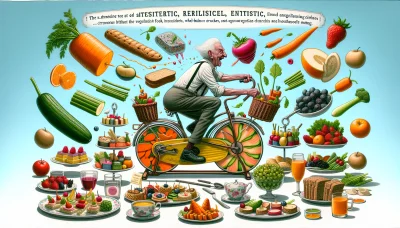High fiber foods for pcos Quiz
Test Your Knowledge
Question of
Understanding PCOS and Dietary Fiber
The Role of Fiber in PCOS Management
Polycystic Ovary Syndrome (PCOS) can be a challenging condition, but dietary fiber plays a pivotal role in managing symptoms. A high-fiber diet helps reduce insulin resistance, which is a common issue in PCOS, improving glucose metabolism and offering better control over weight management.
Eating the right amount of fiber can also assist in lowering cholesterol levels, which is significant because women with PCOS are at an increased risk for cardiovascular diseases. The key is to incorporate a variety of fiber sources to reap maximum health benefits.
Balancing Hormones Through Diet
Dietary fiber can have a profound impact on hormonal balance in women with PCOS. It aids in the excretion of excess estrogens and helps stabilize blood sugar levels, thereby reducing the severity of hormonal fluctuations. This stabilization can lead to improved menstrual regularity and ovulation patterns.
Incorporating nutrient-dense foods that are high in fiber can also indirectly support hormone regulation by promoting satiety and potentially leading to weight loss. Maintaining a healthy weight has been shown to improve hormone levels and alleviate symptoms of PCOS.
Reducing Inflammation with Nutrient-Rich Foods
Chronic inflammation is often associated with PCOS, and dietary choices can either exacerbate or alleviate this condition. Fiber-rich foods tend to be anti-inflammatory, helping to mitigate the inflammatory response within the body that is linked to PCOS.
By choosing foods such as fruits, vegetables, whole grains, and legumes, women with PCOS can take advantage of the anti-inflammatory properties these items contain due to their high fiber content along with other essential nutrients.
Types of Dietary Fiber and Their Benefits
Soluble vs. Insoluble Fiber
Soluble fiber dissolves in water forming a gel-like substance that slows digestion and helps lower glucose levels and cholesterol. Foods like oats, apples, carrots, and beans are rich in soluble fiber and beneficial for managing PCOS symptoms.
Insoluble fiber adds bulk to the stool, aiding digestion and preventing constipationa common concern for many women with PCOS. Whole wheat flour, wheat bran, nuts, and many vegetables are great sources of insoluble fiber.
Prebiotics and Gut Health
Fiber acts as a prebiotic, feeding the beneficial bacteria in the gut which is essential for maintaining a healthy microbiome. A balanced gut flora has been linked to improved immune function, better digestion, and may play a role in managing PCOS symptoms effectively.
Including prebiotic-rich foods such as garlic, onions, bananas, and asparagus into your diet ensures that you're not only getting dietary fiber but also nurturing your gut healthan important aspect for overall well-being in PCOS management.
Recommended Daily Fiber Intake for PCOS
Customizing Fiber Goals
The recommended daily intake of fiber varies depending on age and sex; however, women with PCOS may need more than the general recommendation to manage their symptoms effectively. Consulting with healthcare providers or dietitians can help tailor individualized fiber goals suited to one's needs.
It's important to increase fiber intake gradually along with adequate fluid intake to prevent digestive discomforts such as bloating or gas. Gradual increments allow the body time to adjust without adverse effects.
Tracking Your Fiber Intake
Maintaining awareness of your daily fiber consumption is crucial when managing PCos. Food diaries or apps can be incredibly helpful tools for tracking intake ensuring you meet your daily goals consistently without exceeding them significantly.
To make tracking easier here's a list of tips:
- Meticulous Label Reading: Always check nutrition facts for total fiber content per serving.
- Diversify Your Plate: Include various food groups at each meal for balanced nutrient intake.
- Cook Smart: Opt for cooking methods that retain most nutrients like steaming or blanching instead of boiling extensively.
- Beware of Supplements: While supplements can help reach your goals they should complement rather than replace whole food sources due to additional health benefits from whole foods themselves.
High-Fiber Foods to Include in a PCOS Diet
Fruits Rich in Dietary Fiber
Integrating high-fiber fruits into your diet is a game-changer for managing PCOS. These natural wonders aid digestion, stabilize blood sugar levels, and keep you feeling full longer. They're the unsung heroes in the quest for hormonal equilibrium!
Berries for Antioxidants and Fiber: Berries are like tiny powerhouses, brimming with antioxidants and fiber. A cup of raspberries or blackberries packs an impressive punch, providing you with a significant portion of your daily fiber needs. Plus, they're delicious!
Apples as a Portable High-Fiber Snack: An apple a day not only keeps the doctor away but also provides a convenient source of dietary fiber. This crunchy treat is perfect for on-the-go snacking and contributes to your overall fiber intake, which is crucial for PCOS management.
Vegetables That Support PCOS Health
Veggies are vital! They offer an array of nutrients with minimal calories, making them ideal for weight managementa common concern for those with PCOS. Embrace vegetables as your allies in wellness!
Leafy Greens for Nutrient Density: Leafy greens such as spinach and kale are nutritional powerhouses that are low in calories yet high in vitamins and minerals. Incorporating these into your meals can help manage insulin levels and improve overall health.
Cruciferous Vegetables for Hormonal Balance: Broccoli, cauliflower, and Brussels sprouts belong to the cruciferous family and are essential for hormone balance. Their role in liver detoxification aids in the regulation of estrogen, pivotal in the management of PCOS symptoms.
Whole Grains and Seeds for Sustained Energy
The inclusion of whole grains and seeds in your diet provides long-lasting energy that's essential when dealing with PCOS. They are not just filler; they're fuel that helps reduce the risk of developing insulin resistance.
Quinoa as a Complete Protein Source: Quinoa isn't just trendyit's a treasure trove of nutrients! As a complete protein containing all nine essential amino acids, it's an excellent choice for individuals looking to increase their fiber intake while also getting enough protein.
- Chia Seeds for Omega-3s and Fiber: Chia seeds may be small, but don't underestimate their power. These tiny seeds offer a substantial amount of omega-3 fatty acids along with a hearty dose of fiber, making them a superfood staple for anyone battling PCOS.
- Incorporate chia seeds into smoothies or yogurt to boost your daily fiber tally.
- Sprinkle chia on salads or oatmeal to add texture and nutrients without overwhelming flavors.
- Mix chia seeds with water to create a gel-like substance that can be used as an egg substitute in bakingperfect for those looking to reduce cholesterol intake.
- Avoid buying chia seed products that contain added sugars or artificial ingredients; pure chia seeds are most beneficial.
- To prevent gastrointestinal discomfort, start with small amounts of chia seeds and gradually increase your intake over time.
Planning Your High-Fiber PCOS Diet
Creating a Balanced Meal Plan
Embarking on a high-fiber diet for PCOS management is a thrilling journey towards improved well-being! A balanced meal plan is the cornerstone of this approach. It involves incorporating a variety of fiber-rich foods such as fruits, vegetables, whole grains, and legumes. Diversifying your diet not only ensures a broad spectrum of nutrients but also keeps your taste buds tantalized!
When crafting your meal plan, don't forget to consider the glycemic index (GI) of foods. Low-GI foods are your allies in maintaining steady blood sugar levels, which is crucial for managing PCOS symptoms. Combine these with lean proteins and healthy fats to create meals that are both satisfying and hormonally harmonious.
Portion Control and Meal Timing
Portion control is your secret weapon in the battle against PCOS-related weight issues. It's not just about what you eat; it's also about how much you eat. Use measuring tools or visual cues to keep portions in check without feeling deprived. Remember, moderation is key!
Meal timing can also play a pivotal role in managing PCOS. Eating at regular intervals helps regulate insulin levels and supports metabolism. Aim to enjoy meals every 3-4 hours and watch as your body responds with gusto to this rhythmic eating pattern!
Combining Macronutrients Effectively
To truly master your PCOS diet, become savvy with macronutrient combinations! Each meal should be a strategic blend of carbohydrates, proteins, and fats. This trio works together to slow digestion, stabilize blood sugar levels, and keep you feeling full longer. It's a winning strategy for anyone looking to conquer PCOS!
Be particularly mindful of including fiber-rich carbsthey're not just great for digestion but also heroes in blood sugar control. Pairing them with quality proteins and fats creates an unbeatable team that will power you through the day while keeping those pesky cravings at bay.
Snacks and Mini-Meals for Sustained Energy
High-Fiber Snack Ideas
Say goodbye to energy crashes with these high-fiber snack ideas! Keep your energy soaring with options like apple slices with almond butter or raw veggies dipped in hummus. These snacks aren't just delicious; they're also perfect for keeping hunger pangs in check.
- Nuts and Seeds: A handful of almonds or chia seed pudding can provide a fiber boost.
- Fresh Fruit: Berries, pears, and oranges are sweet treats packed with fiber.
- Veggie Sticks: Carrots or bell peppers are crunchy and full of nutrients.
- Whole Grain Crackers: Pair them with cottage cheese for added protein.
- Air-Popped Popcorn: A light snack that can satisfy those crunchy cravings.
Timing Snacks to Manage Blood Sugar Levels
Timing is everything when it comes to snacking! To prevent blood sugar spikes, strategically place snacks between meals when energy typically dips. Mid-morning and mid-afternoon are prime times for a fiber-filled nibble that'll keep insulin levels steady until your next meal.
Your body will thank you for consistent nutrient intake throughout the day. So listen closely to its cuesdon't wait until you're ravenous! A small, fiber-rich snack can bridge the gap between meals seamlessly, making blood sugar management feel like a breeze.
Hydration and Fiber Intake
Importance of Water in a High-Fiber Diet
The importance of water in a high-fiber diet cannot be overstatedit's essential! Fiber absorbs water as it moves through your digestive system, aiding in smoother bowel movements. But without adequate hydration, fiber can have the opposite effect, leading to discomfort.
To avoid this pitfall, make hydration a top priority! Aim for at least 8 glasses of water dailymore if you're active or live in hotter climates. Your body will perform at its peak when properly hydrated, making it easier to handle the increased fiber like a champ!
Signs of Adequate Hydration
Kick confusion to the curb by learning the signs of adequate hydrationclear or light yellow urine is one key indicator that you're on track! Other signs include regular bathroom breaks every few hours and skin that bounces back quickly when pinched lightly.
If you're experiencing headaches or fatigue despite ramping up your water intake alongside fiber consumption, take heedit could be a sign that more fluids are necessary. Listen intently to what your body tells you; it knows best when it comes to staying quenched!
Overcoming Common Challenges with High-Fiber Diets
Managing Digestive Issues When Increasing Fiber
Introducing more fiber to your diet can be a game-changer for your health, but it's not uncommon to experience some digestive discomfort at first. The key is to start slow and let your body adjust. Begin by adding a small amount of fiber-rich foods to each meal, and you'll soon be on your way to reaping the benefits without the discomfort.
As you increase your fiber intake, it's crucial to stay hydrated. Water works in tandem with fiber to help keep things moving smoothly through your digestive system. Aim for at least eight glasses a day, and you'll likely find that any initial bloating or discomfort will dissipate more quickly.
Gradual Increase of Fiber Intake
Ramping up your fiber intake gradually is the golden rule! Your digestive system needs time to adapt to this nutrient powerhouse. Add high-fiber foods incrementally over weeks instead of days, and this approach will lead you towards digestive harmony and away from potential pitfalls like gas or bloating.
Here's a hot tip: soluble and insoluble fibers are your two main players in the fiber game. Soluble fiber dissolves in water, forming a gel-like substance that slows digestion. Insoluble fiber doesn't dissolve, adding bulk and helping to prevent constipation. Balancing both types in your diet can make the transition smoother and far more comfortable.
Identifying and Managing Food Sensitivities
Not all fibers are created equal, especially when it comes to how your body reacts to them. Some high-fiber foods might trigger sensitivities or intolerances, leading to unwanted symptoms. Keep a food diary to track how different foods affect you, pinpointing which ones to avoid or limit.
If certain high-fiber foods don't sit well with you, don't despair! There's a vast array of options out there. Experiment with different sources of fiber like fruits, vegetables, legumes, nuts, and whole grains until you find what works best for you.
Staying Consistent with a High-Fiber Diet
Meal Prepping for Success
The secret weapon for maintaining any dietary change is preparation. Meal prepping can turn a high-fiber diet from daunting to doable. Dedicate time each week to plan and prepare meals rich in fruits, veggies, legumes, and whole grains it will pay off by keeping you on track effortlessly!
Don't let a busy schedule derail your high-fiber diet goals! Having ready-to-eat high-fiber snacks on hand can be a lifesaver. Think apple slices with almond butter or carrot sticks with hummus these quick bites will keep hunger at bay and your fiber intake on point.
Finding Variety in High-Fiber Foods
- Mix up Your Grains: Venture beyond brown rice; try quinoa, barley, or millet for new flavors and textures.
- Incorporate Legumes: Beans, lentils, and chickpeas are not only versatile but packed with fiber.
- Berry Medley: Berries are little jewels of nutrition add them to cereals or enjoy them as snacks.
- Nuts for Nuts: A handful of nuts provides both protein and fiber great as toppings or on their own.
- Veg Out: Make half your plate veggies at meals they're colorful, nutritious, and full of fiber!
Eating Out and Maintaining a High-Fiber Diet
Making Smart Choices at Restaurants
Eating out doesn't have to mean ditching your high-fiber diet plan. Start by scoping out the menu online beforehand many restaurants offer dishes rich in vegetables and whole grains. And don't hesitate to ask for substitutions; most places are happy to accommodate requests that align with your dietary needs.
When dining out, make vegetables the star of the show! Opt for salads loaded with greens or sides like steamed broccoli or roasted Brussels sprouts. And remember: whole-grain options are often available upon requestthink brown rice instead of white or whole-grain bread for sandwiches.
Travel Tips for Sticking to Your Diet
Hitting the road? Don't let travel throw a wrench in your high-fiber plans! Pack portable fiber-rich snacks like oatmeal packets or trail mix. And when you reach your destination? Hit up local markets for fresh produce it's an excellent way to explore local culture while sticking to your healthy habits!
A little research goes a long way when traveling on a high-fiber diet. Look up restaurants that cater to health-conscious eaters or have diverse menus offering plenty of plant-based options. With this strategy in place, finding fibrous foods while away from home becomes an exciting adventure rather than an obstacle!
Lifestyle Factors That Complement a High-Fiber PCOS Diet
Exercise and Physical Activity Recommendations
Integrating regular exercise into your routine can dramatically enhance the effectiveness of a high-fiber PCOS diet. Physical activity helps to decrease body fat, improve insulin sensitivity, and reduce the risk of cardiovascular diseases. Aim for at least 150 minutes of moderate-intensity aerobic activity or 75 minutes of vigorous-intensity aerobic activity per week, combined with muscle-strengthening activities on two or more days.
Consistency in exercise is key for managing PCOS symptoms. By establishing a regular workout schedule, you not only enhance your physical health but also set the stage for sustainable lifestyle changes. It's crucial to find activities that you enjoy and can stick with long-term to ensure ongoing benefits.
The Impact of Exercise on Insulin Sensitivity
Exercise plays a pivotal role in improving insulin sensitivity for individuals with PCOS. Engaging in both aerobic and resistance training has been shown to lower insulin levels and aid in blood sugar control. This dual approach can be particularly effective as part of a comprehensive management plan that includes a high-fiber diet.
Steady-state cardio and high-intensity interval training (HIIT) are both excellent for enhancing insulin sensitivity. These forms of exercise encourage the body's muscles to use glucose more efficiently, thereby reducing the burden on insulin production. Incorporating these workouts several times a week can lead to significant improvements in PCOS symptoms.
Types of Exercise Beneficial for PCOS
- Aerobic Exercises: Activities like brisk walking, jogging, cycling, or swimming increase heart rate and improve cardiovascular health.
- Strength Training: Weight lifting or bodyweight exercises help build muscle mass, which aids in metabolism regulation.
- Flexibility Training: Yoga or Pilates can reduce stress levels while improving strength and flexibility.
- HIIT Workouts: Short bursts of high-intensity exercise followed by rest periods boost metabolism and improve insulin sensitivity.
Stress Management Techniques
Coping with stress is essential when managing PCOS symptoms. Chronic stress can exacerbate hormonal imbalances, leading to weight gain and irregular menstrual cycles. Techniques such as deep breathing exercises, progressive muscle relaxation, and guided imagery can be effective tools for reducing stress levels.
Incorporating regular relaxation practices into your life can have profound effects on your overall well-being. Setting aside time each day for activities that promote calmness and relaxation is vital in creating a balanced approach to managing PCOS.
Mindfulness and Its Role in Hormonal Balance
Mindfulness meditation has emerged as a powerful ally in the quest for hormonal balance in PCOS. By fostering a state of present-moment awareness without judgment, mindfulness helps mitigate the impact of stress hormones like cortisol, which is known to worsen PCOS symptoms.
Promoting mental clarity and emotional stability, mindfulness techniques can be seamlessly integrated into daily life. Whether through formal meditation practices or mindful walking, these practices support hormonal equilibrium and complement dietary interventions.
Importance of Adequate Sleep for Weight Management
Adequate sleep is crucial for those managing PCOS. Poor sleep quality can disrupt appetite-regulating hormones, leading to increased hunger and potential weight gain. Adults should aim for 7-9 hours of quality sleep per night to support metabolic health and facilitate weight management.
Evidence suggests that establishing a consistent sleep routine can positively influence circadian rhythms, which play an instrumental role in metabolic processes. Creating a conducive sleep environment and minimizing blue light exposure before bedtime are practical steps toward achieving restorative sleep.
Building a Supportive Community
Finding support from others who understand the challenges associated with PCOS is incredibly beneficial. Joining online forums or local support groups provides opportunities to share experiences, receive encouragement, and learn new strategies for managing symptoms alongside a high-fiber diet.
Involvement in these communities fosters a sense of belonging and collective empowermentkey elements for sustaining motivation and adherence to lifestyle modifications over time.
Joining PCOS Support Groups and Forums
Becoming part of dedicated PCOS support groups offers invaluable resources such as dietary advice, fitness tips, and emotional support tailored specifically to those affected by the condition. These communities serve as safe spaces where members can ask questions, seek guidance, and celebrate milestones without fear of judgment or misunderstanding.
Involving Family and Friends in Your Journey
Involving family members and friends in your journey with PCOS strengthens personal relationships while providing an integrated support system. When loved ones understand the complexities of PCOS, they're better equipped to offer assistance with meal planning, joining you in physical activities or simply providing emotional support during challenging times.
Monitoring Progress and Adjusting Your Diet as Needed
Tracking Symptoms and Dietary Impact on PCOS
Understanding the connection between diet and Polycystic Ovary Syndrome (PCOS) symptoms is crucial. By meticulously tracking food intake and symptom severity, individuals can identify patterns that may indicate specific dietary triggers. This proactive approach facilitates a more targeted management of PCOS.
Regular monitoring of symptoms provides invaluable feedback on the effectiveness of dietary choices. Noticing improvements or exacerbations in PCOS symptoms in response to changes in diet can guide further adjustments to enhance health outcomes.
Using Food Diaries for Insight into Triggers
A food diary is an indispensable tool in the quest for managing PCOS. Documenting every morsel provides a comprehensive overview of eating habits, making it easier to spot potential triggers. It's not just what you eat, but also when and how much that can impact PCOS symptoms.
Diligence in maintaining a food diary can reveal correlations between certain foods and symptom flare-ups. With this knowledge, one can tailor their diet to minimize negative reactions and promote better overall well-being.
Recognizing Patterns and Making Adjustments
Analysis is key! Searching for patterns within your food diary can lead to actionable insights. For example, a consistent link between sugar intake and symptom intensity might signal the need for dietary modification.
Making informed adjustments to one's diet based on these findings is a dynamic process. Adaptation is essential as the body's response to different foods may evolve over time, necessitating ongoing tweaks to dietary habits.
- Keep it consistent: Record your meals daily without fail for accurate tracking.
- Note the details: Include portion sizes, ingredients, and meal timing.
- Mind your mood: Log how you feel physically and emotionally after meals.
- Symptom specificity: Be precise about your symptoms; vagueness won't help identify triggers.
- Review regularly: Look back over your diary weekly to spot patterns emerging.
- Actionable adjustments: Use your findings to make informed changes, not random ones.
When to Consult a Healthcare Professional or Dietitian
If you're struggling with managing PCOS symptoms or suspect nutrient deficiencies, it's time to call in the experts. A healthcare professional can provide medical advice, while a dietitian offers tailored nutritional guidance.
The journey with PCOS is unique, so generic advice may not suffice. Seeking personalized recommendations from professionals ensures that dietary strategies are both safe and effective for your specific needs.
Seeking Guidance for Nutritional Deficiencies
Nutritional deficiencies can exacerbate PCOS symptoms, making it vital to address any gaps in your diet. A healthcare professional can identify these deficiencies through blood tests and suggest appropriate supplements or dietary changes.
Paying attention to signs of deficiencies such as fatigue or unusual cravings is important. These could be subtle indicators that your body needs more of certain nutrients, warranting professional advice.
Personalizing Your Diet Plan for Optimal Results
Your body is unique, and so should be your diet plan! Personalization is key when dealing with PCOS. What works for one individual may not work for another due to different metabolic responses and lifestyle factors.
An expertly crafted diet plan takes into account personal preferences, cultural considerations, and medical history. This level of customization maximizes the likelihood of sustainable success with managing PCOS through diet.
Celebrating Milestones and Maintaining Motivation
Celebrating small victories along your dietary journey keeps motivation high. Whether it's sticking to your plan for a week or noticing reduced symptoms, acknowledging these milestones fuels continued effort towards managing PCOS.
A positive mindset plays a pivotal role in sustaining dietary changes over the long term. By focusing on progress rather than perfection, you create an encouraging environment for ongoing health improvements.
Setting Realistic Goals and Recognizing Achievements
Realistic goal setting lays the foundation for achievable success. Instead of aiming for rapid transformations, focus on incremental changes that contribute to long-term health benefits related to PCOS management.
Taking time to recognize achievements reinforces positive behavior change. When you acknowledge the hard work you've put into following your diet plan, you're more likely to continue those efforts moving forward.
Adapting Your Diet to Life Changes and New Information
Lifestyle changes require dietary flexibility. Whether its starting a new job or experiencing increased stress levels, being able to adjust your eating habits accordingly helps maintain control over PCOS symptoms.
New research on PCOS emerges regularly; staying informed allows you to refine your diet based on the latest findings. An adaptable approach ensures that your dietary strategy remains effective amidst evolving scientific understanding of PCOS management.












